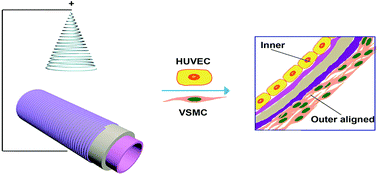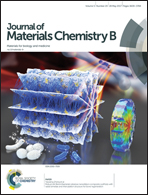A bio-inspired high strength three-layer nanofiber vascular graft with structure guided cell growth†
Abstract
Human natural blood vessels have a three-layer structure including the tunica intima, tunica media, and tunica adventitia. These subtle structures endow healthy blood vessels with outstanding strength, elasticity, and compliance as well as excellent haemodynamic and anti-thrombus performance. Fabrication of a next generation vascular graft that mimics the structures and functions of natural blood vessels is becoming the pursuit of biomaterials and medical scientists. Here we fabricate a bio-inspired nanofiber three-layer vascular graft by electrospinning. The inner PLA/PCL layer is favorable for adhesion of human umbilical vein endothelial cells that could accelerate endothelialization. The middle PU/PCL layer provides superior mechanical properties (63.40 MPa, 266.78% in the longitudinal direction and 52.34 MPa, 319.72% in the lateral direction). The outer PLA/PCL layer with circumferentially aligned fibers is beneficial for guiding vascular smooth muscle cells in the circumferentially oriented direction. The bio-inspired three-layer vascular graft with strong mechanical properties and good cell biocompatibility will play an important role in vessel remodeling and regeneration.



 Please wait while we load your content...
Please wait while we load your content...